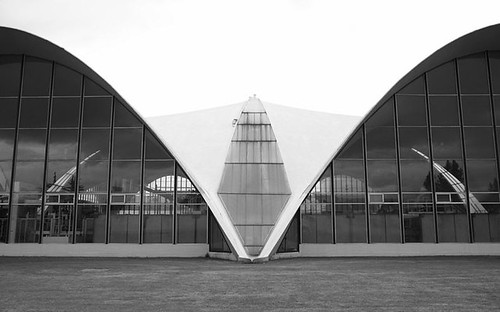A common misconception within the Architecture/Engineering/Construction
community is that structural steel is a carbon-intense, “dirty” product which sabotages
the natural environment by utilizing large amounts of mined content. In reality, the steel structure being
fabricated for your current project has a decent chance of containing metal
from a car similar to the one you were driving when you were 16.
Figure 1 - The
structural steel life cycle Credit: American Institute of Steel Construction
Domestic structural steel and rebar are produced with an
average of 90% recycled content. The process
in which they are produced transitioned in the late 1970s from the Basic Oxygen
Furnace (BOF) process to the Electric Arc Furnace Process (EAF). This shift resulted in a 24-fold increase in
productivity - from 12 hours per ton of steel to one-half of an hour per ton. Steel products are also transported
efficiently in the US, with the majority of steel being transported via barge
or rail rather than truck.
Some lighter gage material, like decking and light gage
studs, as well as Hollow Structural Sections (HSS) are made via both EAF and
BOF. The BOF process utilizes
approximately 30% recycled content. It
is important to be able to differentiate between production processes for all
types of steel used on your project when accounting for the carbon impact. (In this post, as well as the carbon working
group white paper, the term “carbon” is used to mean “carbon-dioxide
equivalent.”) Versions 2 and 3 of the LEED rating system assume a 25% recycled
content for all steel products as a default unless documentation via mill-specific
data is provided. In LEED v4,
mill-specific recycled content data can be used to achieve the Leadership
Extraction Practices option of the Building Product Disclosure and Optimization
credit.
The cradle-to-gate Environmental Product Declarations (EPDs)
released by the American Institute of Steel Construction (AISC) in 2016 for
fabricated hot-rolled structural shapes, fabricated HSS, and fabricated plate
material provide a full accounting of material sourcing, production, transportation
to fabrication shop, and labor and processing in the shop. However, only
fabricators who were members of the Institute when it was produced (or have
since joined and submitted environmental data) are able to legally use these
EPDs to account for carbon content on their structures.
The EPD for Fabricated Hot-Rolled Structural Sections gives
results for the impact category of Global Warming Potential (GWP) as 1.16 tons
CO2e per ton of steel produced, with approximately 85% of the total
impact coming from the furnace production process. With the material production impact being the
dominant contributor to the total impacts, it is important to be sensitive to
overall material use when lessening carbon impacts is the overall goal.
Figure 2 - Comparison of structural steel frame in the Empire
State building as constructed in 1931 vs. now.
Carbon emissions numbers include material production only. Credit: American Institute of Steel
Construction
Material, however, is only one side of the coin regarding
overall sustainability. An argument can
be made that designing an erection-friendly structure can also lessen carbon
impacts by reducing schedule and saving weeks of labor in the field, although
this has yet to be quantified by an official EPD or Life Cycle Analysis (LCA).
In order to find the “sweet spot” where material efficiency,
up-front cost, life-cycle cost, and resiliency come together, one needs to
discuss specific project goals with the structural steel fabricator as early as
possible – preferably as a preconstruction partner. The fabricator will be able to educate the
design team on local material supply, desired connection schemes, how material
can most efficiently run through their shop, as well as be efficiently sequenced
in the field. They can aid in implementing green goals such as overall material
reduction (both with a material efficient structure and by exposing structure
to reduce finishes), material reuse, and integrated process credits.
The Steel chapter of the upcoming White Paper “Structures
and Carbon” describes and compares production processes used domestically. Specific strategies to produce a
carbon-efficient structure are presented.
We look forward to your reviews and comments!
















